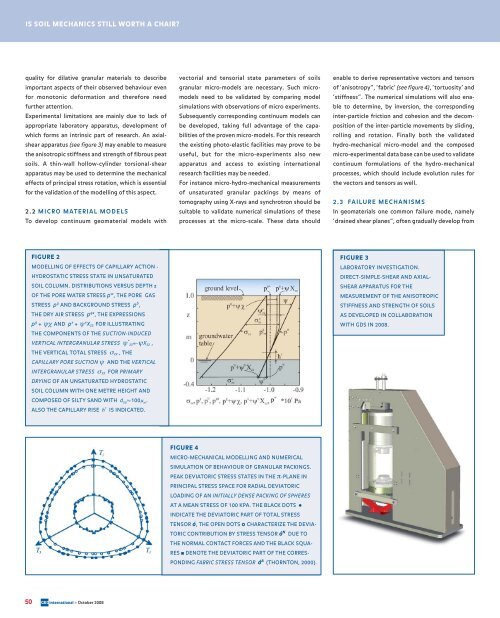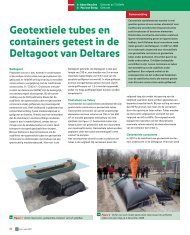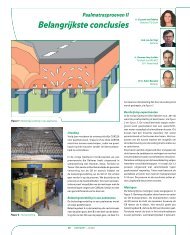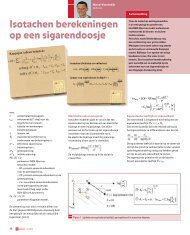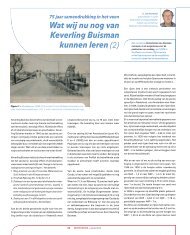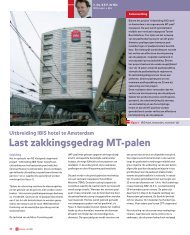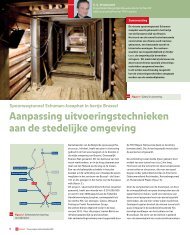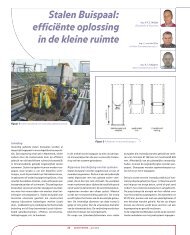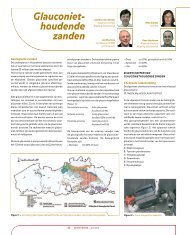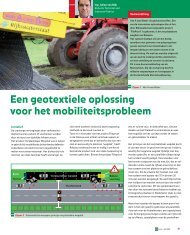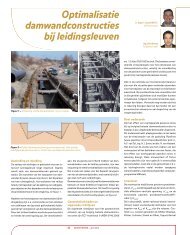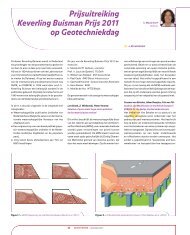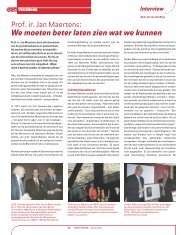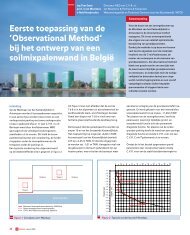i137 GEO binnen - GeoTechniek
i137 GEO binnen - GeoTechniek
i137 GEO binnen - GeoTechniek
You also want an ePaper? Increase the reach of your titles
YUMPU automatically turns print PDFs into web optimized ePapers that Google loves.
IS SOIL MECHANICS STILL WORTH A CHAIR?<br />
quality for dilative granular materials to describe<br />
important aspects of their observed behaviour even<br />
for monotonic deformation and therefore need<br />
further attention.<br />
Experimental limitations are mainly due to lack of<br />
appropriate laboratory apparatus, development of<br />
which forms an intrinsic part of research. An axialshear<br />
apparatus (see figure 3) may enable to measure<br />
the anisotropic stiffness and strength of fibrous peat<br />
soils. A thin-wall hollow-cylinder torsional-shear<br />
apparatus may be used to determine the mechanical<br />
effects of principal stress rotation, which is essential<br />
for the validation of the modelling of this aspect.<br />
2.2 MICRO MATERIAL MODELS<br />
To develop continuum geomaterial models with<br />
FIGURE 2<br />
MODELLING OF EFFECTS OF CAPILLARY ACTION -<br />
HYDROSTATIC STRESS STATE IN UNSATURATED<br />
SOIL COLUMN. DISTRIBUTIONS VERSUS DEPTH z<br />
OF THE PORE WATER STRESS pw , THE PORE GAS<br />
STRESS pg AND BACKGROUND STRESS pb ,<br />
THE DRY AIR STRESS pga , THE EXPRESSIONS<br />
p g + ψχ AND p x + ψ x Xzz FOR ILLUSTRATING<br />
THE COMPONENTS OF THE SUCTION-INDUCED<br />
VERTICAL INTERGRANULAR STRESS ψ * zz=-ψ Xzz ,<br />
THE VERTICAL TOTAL STRESS σ zz , THE<br />
CAPILLARY PORE SUCTION ψ AND THE VERTICAL<br />
INTERGRANULAR STRESS σ zz FOR PRIMARY<br />
DRYING OF AN UNSATURATED HYDROSTATIC<br />
SOIL COLUMN WITH ONE METRE HEIGHT AND<br />
COMPOSED OF SILTY SAND WITH d50100µ m .<br />
ALSO THE CAPILLARY RISE h c IS INDICATED.<br />
50 <strong>GEO</strong>international – October 2008<br />
vectorial and tensorial state parameters of soils<br />
granular micro-models are necessary. Such micromodels<br />
need to be validated by comparing model<br />
simulations with observations of micro experiments.<br />
Subsequently corresponding continuum models can<br />
be developed, taking full advantage of the capabilities<br />
of the proven micro-models. For this research<br />
the existing photo-elastic facilities may prove to be<br />
useful, but for the micro-experiments also new<br />
apparatus and access to existing international<br />
research facilities may be needed.<br />
For instance micro-hydro-mechanical measurements<br />
of unsaturated granular packings by means of<br />
tomography using X-rays and synchrotron should be<br />
suitable to validate numerical simulations of these<br />
processes at the micro-scale. These data should<br />
FIGURE 4<br />
MICRO-MECHANICAL MODELLING AND NUMERICAL<br />
SIMULATION OF BEHAVIOUR OF GRANULAR PACKINGS.<br />
PEAK DEVIATORIC STRESS STATES IN THE π-PLANE IN<br />
PRINCIPAL STRESS SPACE FOR RADIAL DEVIATORIC<br />
LOADING OF AN INITIALLY DENSE PACKING OF SPHERES<br />
AT A MEAN STRESS OF 100 KPA. THE BLACK DOTS •<br />
INDICATE THE DEVIATORIC PART OF TOTAL STRESS<br />
TENSOR ó, THE OPEN DOTS o CHARACTERIZE THE DEVIA-<br />
TORIC CONTRIBUTION BY STRESS TENSOR óN DUE TO<br />
THE NORMAL CONTACT FORCES AND THE BLACK SQUA-<br />
RES DENOTE THE DEVIATORIC PART OF THE CORRES-<br />
PONDING FABRIC STRESS TENSOR óA (THORNTON, 2000).<br />
enable to derive representative vectors and tensors<br />
of ‘anisotropy”, ‘fabric’ (see figure 4), ‘tortuosity’ and<br />
‘stiffness”. The numerical simulations will also enable<br />
to determine, by inversion, the corresponding<br />
inter-particle friction and cohesion and the decomposition<br />
of the inter-particle movements by sliding,<br />
rolling and rotation. Finally both the validated<br />
hydro-mechanical micro-model and the composed<br />
micro-experimental data base can be used to validate<br />
continuum formulations of the hydro-mechanical<br />
processes, which should include evolution rules for<br />
the vectors and tensors as well.<br />
2.3 FAILURE MECHANISMS<br />
In geomaterials one common failure mode, namely<br />
‘drained shear planes”, often gradually develop from<br />
FIGURE 3<br />
LABORATORY INVESTIGATION.<br />
DIRECT-SIMPLE-SHEAR AND AXIAL-<br />
SHEAR APPARATUS FOR THE<br />
MEASUREMENT OF THE ANISOTROPIC<br />
STIFFNESS AND STRENGTH OF SOILS<br />
AS DEVELOPED IN COLLABORATION<br />
WITH GDS IN 2008.


